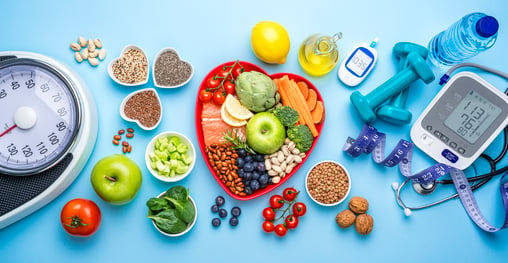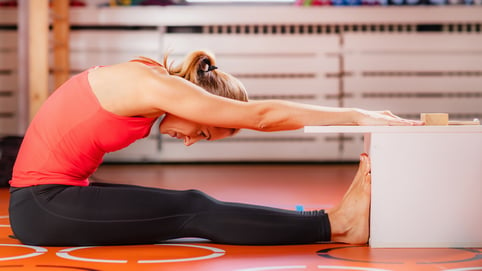What if a single metric could help predict your risk of heart disease, diabetes, cancer, or even early death? Waist-to-hip ratio (WHR) can do exactly that! In a world focused on numbers on the scale or BMI metrics, simply comparing the circumference of your waist to your hips can provide insight into fat distribution within the body that weight and BMI cannot, a key factor in understanding overall health. Two people of the same height, weight, and body fat percentage may face disparate health risks due to fat distribution. WHR has become an essential and helpful tool in preventative medicine.
How does one measure WHR?
WHR is the circumference of the waist divided by the circumference of the hips. To measure the circumference of the waist, start by standing upright and exhale. Measure the circumference of the waist with a tape measure, placed above the belly button, at the smallest part of the waist. Measure hip circumference by positioning the measuring tape around the widest part of the hips. According to the World Health Organization (WHO), people may have abdominal obesity if their WHR is above 0.85 for women and 0.90 for men.
WHR allows for a clearer picture of fat distribution. Where the fat in your body is located could have a direct impact on your risk for specific health conditions. Too much fat around the waist, abdominal obesity, may be indicative of visceral fat, adipose tissue that surrounds the organs. This dangerous fat distribution can cause systemic inflammation, leading to higher cholesterol, blood pressure, blood glucose, and triglycerides, a type of fat in your blood, increasing the probability of developing cardiovascular disease, cancer, stroke, kidney disease, and type 2 diabetes. WHR is a superior determinant of these health risks than other metrics, including BMI, obstructive sleep apnea in males without obesity, and infertility in females.
How can we help maintain a proper WHR?
Setting realistic goals, portion control, balanced diet, getting enough sleep, and exercise are a great start. If your WHR is above the standards set by the WHO, consider speaking with a medical professional. Abdominal obesity could be a result of underlying health conditions such as thyroid disease, PCOS, Cushing’s Disease, stress, anxiety, or depression. Exercise can help manage the symptoms of these diseases. Try to achieve a minimum of 150 minutes of moderate intensity exercise each week.
While weight and BMI have long dominated health conversations, WHR allows for a clearer understanding of metabolic health and disease risk. WHR is not just about aesthetics but instead, preventative maintenance on our bodies. Understanding and monitoring your WHR are important steps in improving your overall health. With WHR, your shape tells an important story.


 Staying active and making healthy choices is important, especially as we get older. Strength training and maintaining a healthy body composition can make a big difference in how we move, look, and feel as we age.
Staying active and making healthy choices is important, especially as we get older. Strength training and maintaining a healthy body composition can make a big difference in how we move, look, and feel as we age.
 One of the best things you can do when it comes to tracking your progress with fitness is a fitness assessment. A fitness assessment is roughly a 30–60-minute consultation with a health and fitness professional where you are tested on the 5 components of fitness: body composition, muscular strength, muscular endurance, flexibility, and cardiovascular endurance. Some assessments may also test for balance, mobility, or more sports performance biased like power and agility. But for the sake of this article, we are focusing on the 5 components of fitness.
One of the best things you can do when it comes to tracking your progress with fitness is a fitness assessment. A fitness assessment is roughly a 30–60-minute consultation with a health and fitness professional where you are tested on the 5 components of fitness: body composition, muscular strength, muscular endurance, flexibility, and cardiovascular endurance. Some assessments may also test for balance, mobility, or more sports performance biased like power and agility. But for the sake of this article, we are focusing on the 5 components of fitness.
.jpg?width=404&name=GettyImages-1135376317%20(1).jpg) While practicing social distancing remains a priority for everyone, finding ways to stay physically active should also remain a priority. This is particularly true for older adults who may find themselves feeling increasingly isolated and vulnerable to remain safe. Exercise has long proven to provide numerous health benefits both for your physical well-being as well as your emotional well-being including:
While practicing social distancing remains a priority for everyone, finding ways to stay physically active should also remain a priority. This is particularly true for older adults who may find themselves feeling increasingly isolated and vulnerable to remain safe. Exercise has long proven to provide numerous health benefits both for your physical well-being as well as your emotional well-being including:
 For years, fitness professionals have been trained to use Body Mass Index (BMI) as a prescreening tool when individuals join a fitness program. It was part of the recommendations by the
For years, fitness professionals have been trained to use Body Mass Index (BMI) as a prescreening tool when individuals join a fitness program. It was part of the recommendations by the 
 Body Mass Index (BMI) vs. Body Composition: These measurements are used in the healthcare and corporate fitness worlds to help identify risk for heart disease, diabetes, stroke, and cancer. But which is best? Many experts reason that both tools can be useful in different circumstances.
Body Mass Index (BMI) vs. Body Composition: These measurements are used in the healthcare and corporate fitness worlds to help identify risk for heart disease, diabetes, stroke, and cancer. But which is best? Many experts reason that both tools can be useful in different circumstances.